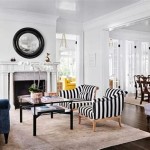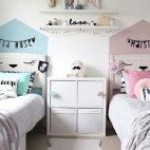How To Decorate a Room For a Boy and a Girl
Decorating a shared bedroom for a boy and a girl poses a unique set of challenges. Individual preferences, developmental stages, and gender-specific interests must be carefully considered to create a space that feels comfortable and personalized for both children. The goal is to achieve a harmonious design that caters to each child's needs while fostering a sense of shared ownership and minimizing potential conflicts. Successful room design requires thoughtful planning, a neutral foundation, and creative strategies for incorporating individual elements.
Initially, assess the children's personalities and interests. Direct communication is crucial. Inquire about their favorite colors, activities, and desired themes. Observe how they interact with their existing belongings and with each other. Understanding their individual needs and preferences forms the foundation for making informed design choices. This information will guide the selection of color palettes, furniture styles, and decorative accents.
Before commencing any physical changes, develop a comprehensive plan. This plan should include a detailed floor plan indicating the placement of furniture, storage solutions, and designated personal spaces. A well-defined plan prevents costly mistakes and ensures efficient utilization of the available space. Consider factors such as natural light sources, window placement, and the location of electrical outlets when optimizing the layout.
Key Point 1: Establishing a Neutral Foundation
Creating a neutral foundation is paramount in a shared bedroom. This involves selecting wall colors, flooring, and large furniture pieces in versatile, gender-neutral tones. Neutral colors such as light gray, off-white, beige, or a soft pastel palette serve as a blank canvas, allowing for the incorporation of individual preferences through accessories and accent pieces. Avoid overly gendered colors like bright pink or deep blue for the primary elements of the room.
Wall color selection can impact the overall ambiance of the room. Light and airy colors create a sense of spaciousness, while warmer neutrals impart a cozy and inviting atmosphere. Consider the amount of natural light the room receives when choosing a wall color. In dimly lit rooms, opt for lighter shades to maximize brightness. Matte or eggshell finishes are preferable over glossy finishes, as they minimize glare and create a softer look.
Flooring should also be neutral and durable to withstand the wear and tear of daily use. Hardwood floors, laminate, or neutral-colored carpeting are suitable options. Consider adding area rugs to delineate individual spaces and introduce texture and color. Rugs can be easily replaced as the children's tastes evolve. When selecting rugs, prioritize materials that are stain-resistant and easy to clean.
Large furniture pieces, such as beds, dressers, and desks, should also adhere to the neutral color scheme. Opt for white, natural wood tones, or gray finishes. These neutral pieces offer versatility and can be easily adapted to different design styles. Invest in high-quality, durable furniture that can withstand the rigors of childhood. Consider furniture with built-in storage to maximize space and minimize clutter.
Key Point 2: Defining Individual Spaces and Personalization
Despite sharing a room, each child needs a designated personal space where they can express their individuality. This can be achieved through various design strategies that create a sense of ownership and privacy. Divide the room visually using furniture placement, color accents, or creative partitions.
A common method for delineating individual spaces is to position the beds on opposite sides of the room. A shared nightstand or a small bookcase can serve as a divider between the beds. Another option is to use a room divider, such as a folding screen or a lightweight curtain, to create a more defined separation. Consider custom-built shelving units that offer both storage and visual separation.
Each child's personal space should reflect their individual interests and preferences. Allow them to choose bedding, curtains, and decorative accessories that resonate with their personality. Incorporate their favorite colors, patterns, and themes into their designated areas. Display their artwork, photographs, and collections to personalize the space. Consider using wall decals or removable wallpaper to add pops of color and personality without making permanent changes.
Storage solutions tailored to each child's needs are essential. Provide separate drawers or shelves for their belongings. Label each storage container with their name or a visual cue to prevent confusion. Encourage them to participate in organizing their personal space to foster a sense of responsibility and ownership. Consider using under-bed storage containers or vertical storage solutions to maximize space.
Key Point 3: Incorporating Shared Elements and Fostering Collaboration
While individual spaces are crucial, it is equally important to create shared elements that promote collaboration and harmony. Designating a common area for play, reading, or studying fosters a sense of togetherness and encourages interaction. Involve both children in the process of selecting shared decorations and furniture to ensure that the space reflects their collective identity.
A shared reading nook with comfortable seating and a well-stocked bookshelf can encourage a love of reading. A play area with a rug, toys, and games provides a space for imaginative play. A shared desk or table offers a dedicated area for homework or creative projects. These shared spaces should be designed to be flexible and adaptable to different activities.
Incorporate shared decorative elements that appeal to both children. A gallery wall with framed artwork or photographs can showcase their shared interests and memories. Decorative pillows, throws, and cushions in coordinating colors and patterns can tie the room together. Consider a shared theme, such as nature, adventure, or animals, that resonates with both children and can be incorporated throughout the room.
Encourage open communication and collaboration throughout the decorating process. Involve both children in making decisions about colors, furniture, and accessories. This fosters a sense of ownership and responsibility, and minimizes potential conflicts. Create a mood board or a visual representation of the proposed design to help them visualize the final result. Be flexible and willing to compromise to ensure that both children feel comfortable and happy in their shared room.
Lighting plays a crucial role in creating a functional and inviting space. Incorporate a variety of light sources, including overhead lighting, task lighting, and ambient lighting. Overhead lighting provides general illumination, while task lighting, such as desk lamps or reading lights, provides focused light for specific activities. Ambient lighting, such as string lights or fairy lights, creates a warm and inviting atmosphere. Ensure that each child has access to adequate lighting in their personal space.
Safety is a paramount consideration when decorating a shared bedroom. Secure furniture to the walls to prevent tipping. Use cordless blinds or shades to eliminate the risk of strangulation. Ensure that all electrical outlets are covered with safety caps. Choose non-toxic paints and materials. Regularly inspect the room for potential hazards and address them promptly. Create a safe and comfortable environment where both children can thrive.
Maintaining a clean and organized shared bedroom requires consistent effort and collaboration. Establish clear expectations for cleanliness and organization. Provide ample storage solutions and encourage the children to use them. Schedule regular cleaning sessions and involve both children in the process. Teach them how to properly store their belongings and how to tidy up after themselves. Celebrate their efforts and reward them for maintaining a clean and organized space.
As the children grow and their interests evolve, the room will need to be updated and adapted. Be prepared to make changes as needed to accommodate their changing needs and preferences. This may involve repainting the walls, replacing furniture, or adding new accessories. Continue to involve both children in the decorating process to ensure that the room remains a comfortable and personalized space for them.

Pin Em Quartos


5 Design Tips For Kids Shared Spaces

26 Best Girl And Boy Shared Bedroom Design Ideas Decoholic

Boy Girl Shared Room Ideas Purewow


21 Brilliant Ideas For Boy And Girl Shared Bedroom

31 Boy And Girl Shared Small Room Ideas Pottery Barn Teen


Boy Girl Shared Bedroom The Full Reveal Anika S Diy Life
Related Posts







